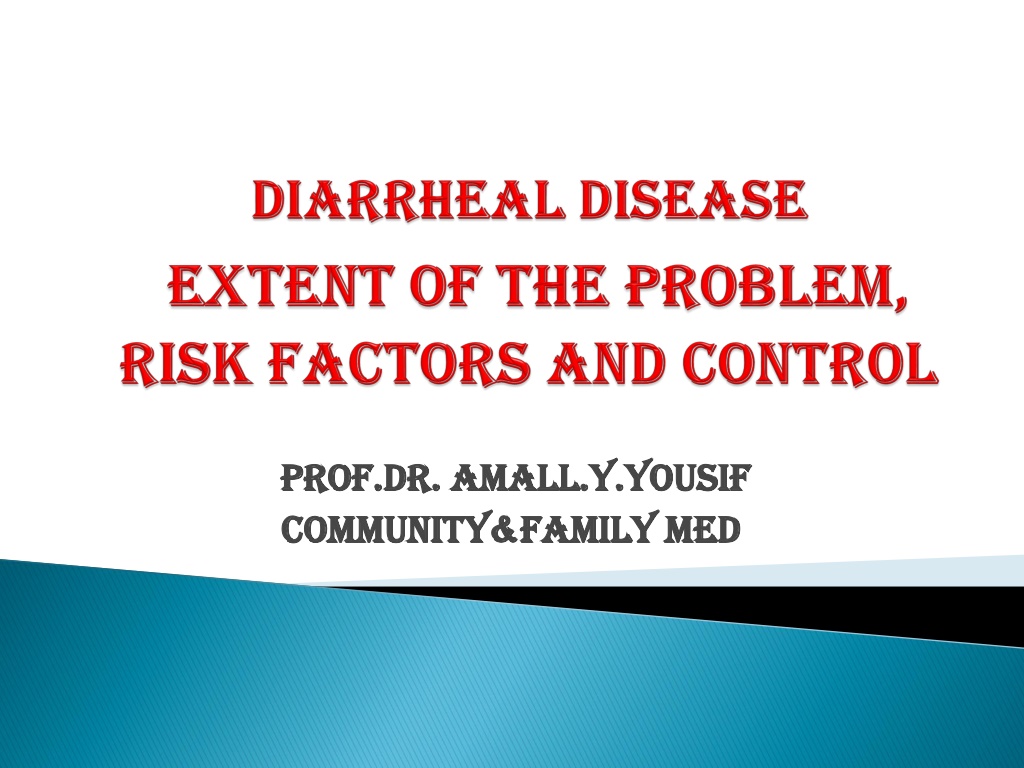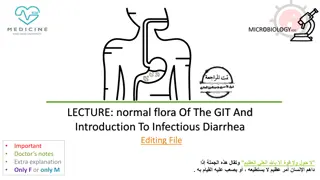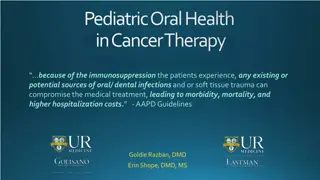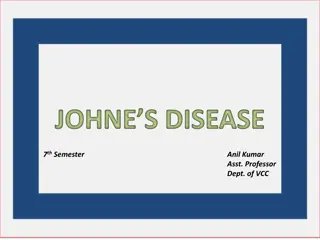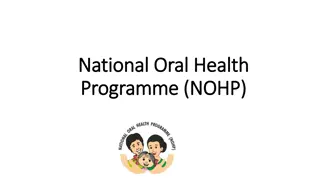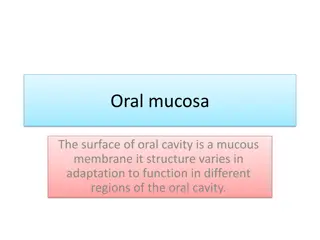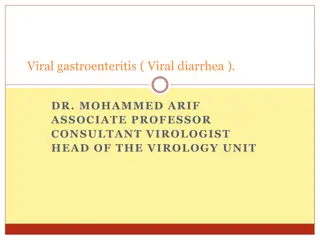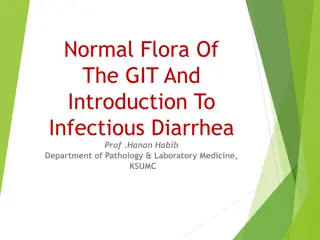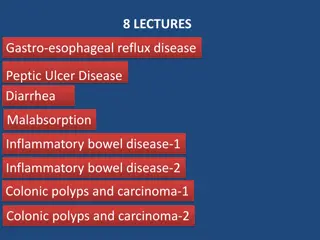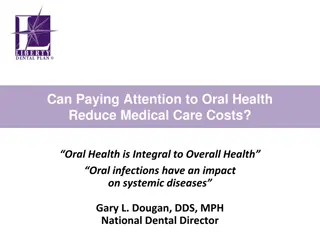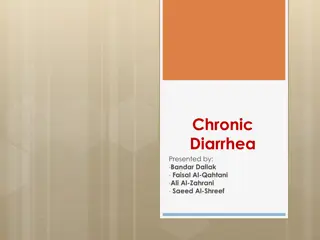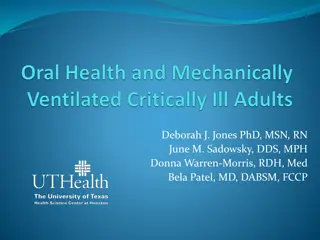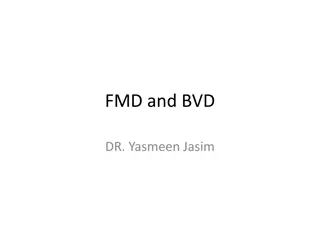Understanding Feco-Oral Diseases and Diarrhea Transmission
Feco-oral diseases, primarily transmitted through the fecal-oral route, remain a significant global health concern, especially affecting children under 5 and the elderly. Diarrhea, characterized by WHO as three or more watery stools in 24 hours, poses a substantial burden, with infectious agents causing the majority of cases. Common bacterial causes include Vibrio cholera, Salmonella, E.coli, Shigella, and Campylobacter, while viral causes include Rota virus, Entero virus, and Adeno virus. Heightened awareness of these infections is crucial for effective prevention and management.
Download Presentation

Please find below an Image/Link to download the presentation.
The content on the website is provided AS IS for your information and personal use only. It may not be sold, licensed, or shared on other websites without obtaining consent from the author. Download presentation by click this link. If you encounter any issues during the download, it is possible that the publisher has removed the file from their server.
E N D
Presentation Transcript
Prof. Prof.Dr Community& Community&Family Dr. . Amall. Amall.Y. Y.Yousif Yousif Family Med Med
The fecaloral route (also called the oralfecal route or orofecal route) describes a particular route of transmission of a disease where pathogens in fecal particles pass from one person to the mouth of another person.
Feco-oral disease are an important cause of morbidity worldwide and represent the second largest cause of death globally among children aged under 5 years. The World Health Organization (WHO) estimates that 1.5 million children in this age group die from diarrheal diseases every year, almost half of them in Africa.
The most vulnerable children are the youngest ones, particularly before their second birthday The elderly remain especially susceptible to the complications of diarrhea and account for 85% of related deaths
Diarrhea : Is derived from Greek word ,meaning (flowing through) defined by WHO: Three or more watery stool in 24hrs or passing more stool than normal for age . Diarrhea defined as acute if present for less than 2 weeks persistent if present for2-4 weeks chronic if greater than 4weeks in duration. Infectious agents account for 90% of cases of acute diarrhea, and bloody diarrhea.
The majority of patient with acute diarrhea not seek medical attention and investigation are frequently omitted in those who do, therefore the prevalence of infectious diarrhea is grossly under estimated. Most are viral, with bacterial stool culture positive less than 5% of presentation
Causes of diarrhea Bacterial causes 1-Vibrio cholera 2-Salmonella 3-E coli 4-Shigella 5-Campylobacter species
Viral causes of diarrhea 1-Rota virus 2-Entero virus 3-Adeno virus Viral gasteroenterpathy is most common etiological agent of the nonbacterial gastroenteritis outbreak worldwide and all age groups are affected.
Parasitic causes of diarrhea 1-Entameba histolytica 2-Giardia lamblia 3-Cryptosporidosis
Other causes of diarrhea 1-Inflammatry bowel disease 2-Ischemic colitis 3-Acut diverticulitis 4-Toxin 5-Hyperthyrodism 6-Diabetus mellitus 7-Antibiotic and medication
Mode of Transmission -Most diarrheal Causative agents are transmitted by the fecal-oral route . -Some viruses ( such as Rotavirus ) can be transmitted through air . -Nosocommial transmission is possible .
faeco-oral transmission means from faeces to mouth. But the route can either be direct transmission from contaminated hands touching the mouth and transferring the infectious agents directly; or indirect transmission through consumption of food or water, or using utensils contaminated with the infectious agents
The common factors in the fecal-oral route can be summarized as five (F): fingers, flies, fields, fluids, and food. Diseases transmitted indirectly by food or water are called foodborne diseases and waterborne diseases respectively.
Person at risk: Cholera : 2 years and above Shigellosis : Children below 5 years . Rotavirus : infants and children aged 1-2 years . E.coli : all age groups . Amoebiasis : adults
Diarrhoea results in dehydration The rapid loss of body fluids and important salts required for proper control of body functions, particularly in the brain, nerves and muscles. Children are highly susceptible to dehydration if they have diarrhoea, even after only one day; they can quickly die if the fluid loss is continuous .
Antimicrobial according to the type of pathogens, most cases of diarrhea are self limiting and cure with supportive therapy. Anti motility and antidiarrhoeal may be toxic and should be avoided. Medical staff and parents have to concentrate on essential treatment which is rehydration
Preventive measures for diarrhea. 1-health education. 2-provision of adequate water supply. 3-effective sewage system and proper sanitation. 4-good personal hygiene and hands washing. 5-control of insects. 6-breast feeding. 7-immunization.
Foodborne illness Food borne disease is defined as a disease caused by agents that enter the body through the ingestion of contaminated food and water. Foodborne illness These agents may be infectious agents or toxic substances. Food borne illnesses have significant impact worldwide including developed nations.
The causes of foodborn illness fall into the following 3 categories: 1. parasites. Bacteria and viruses are responsible for most foodborne illnesses. Biological hazards are the biggest threat to food safety. They can be inherent in the product . Biological hazards include bacteria, viruses, and
2.Chemical hazards due to consumption of food contaminated by chemical poisons. include natural toxins and chemical contaminants Some natural toxins are associated with the food itself (i.e., certain mushrooms) some are made by pathogens in the food when it is time/temperature abused . Some additives, such as sulfites, can be a hazard to some people. Chemical contamination can occur when products (i.e., cleaners) are not used correctly.
Contamination of food can happen at any point during production, growing, harvesting, processing, storing, shipping, or preparing. 3. Physical hazards can include metal shavings from cans and plastic pieces
Pathogens can cause different types of foodborne illness:- Illness can be caused by the pathogens themselves (foodborne infection); caused by toxins produced in the food by pathogens (foodborne intoxication) and caused by toxins produced in the body by pathogens (foodborne toxin-mediated infection).
Clostridium botulinum Escherichia coli Listeria Salmonella Vibrio cholerae Others
Enterovirus Hepatitis A Hepatitis E Rotavirus
Entamoeba histolytica Giardia
Foodborne illness can affect anyone who eats contaminated food; however, certain populations are more susceptible to becoming ill with a greater severity of illness. These populations include infants and children, the elderly, pregnant women, people taking certain kinds of medications or immune suppressed (e.g., cancer patients, diabetics).
CLEAN: Wash your hands and surfaces often. SEPARATE: Don t cross-contamination. COOK: To the right temperature. CHILL: Refrigerate promptly. Bacteria can multiply rapidly if left at room temperature or in the Danger Zone between 40 F and 140 F. Never leave perishable food out for more than 2 hours (or 1 hour if it s hotter than 90 F outside).
CDC estimates that each year 48 million people get sick from a foodborne illness, 128,000 are hospitalized, and 3,000 die. Researchers have identified more than 250 foodborne diseases. Most of them are infections, caused by a variety of bacteria, viruses, and parasites. Harmful toxins and chemicals also can contaminate foods and cause foodborne illness
Dehydration. HUS.(E.COLI) Others: Abortion,still birth(c.botulism) Research suggests that acute foodborne illnesses may lead to chronic disorders, including Reactive arithritis Irritable bowel syndrome. Guillain Barre syndrome.
Prevention and control of foodborne diseases, regardless of the specific cause, are based on the same principles: 1. Avoidance of food contamination 2. Destruction or prevention of contaminants 3. Prevention of further spread or multiplication of contaminants.
Specific modes of intervention vary from area to area depending on environmental, economic, political, technology and socio cultural factors. The preventive and control strategies may be approached based on the major site in the cycle of transmission or acquisition where they are implemented. These involve the activities performed at: -Source of infection, -Environment - Host
1. Source of infection Thorough cooking of raw food. Thorough washing of raw vegetables with clean water Keeping uncooked animal products far separate from cooked and ready-to-eat foods. Avoiding raw milk or foods made from raw milk. Appropriate heat treatment of food items before consumption
Active immunization of animals Inspection of food Sanitary disposal of human wastes Treatment of cases Washing hands, knives, cutting boards, etc. after handling uncooked foods. Avoiding contact with materials contaminated with pet excreta or soil. Decontamination of animal products, e.g., wool, goat hair Burying intact or cremating of infected animal carcasses.
Recognizing, preventing, and controlling of infections in domestic animals, pets. Washing hands after contact with animals Management of food handlers and homemakers Treatment of carriers. Proper care for patients with food-borne illnesses. Avoidance of food from animals with obvious infection, e.g., mastitis in cows Treatment of infections in food handlers such as skin and throat infections
2. Environment This involved stringent follow-up from production to consumption. Some of the interventions include: Freezing, salting, etc. of food items during storage Control of flies, rats, roaches Public education on environmental and personal cleanliness
Surveillance of food establishments Avoiding contamination of food after cooking. Maintenance of sanitary food area. Proper handling and storage of leftover foods Kitchen cleanliness Safe canning at home Careful storage and use of chemicals (storage away from foods)
3. Host Active or passive immunization of susceptible hosts Health education.
